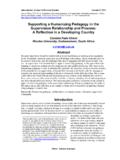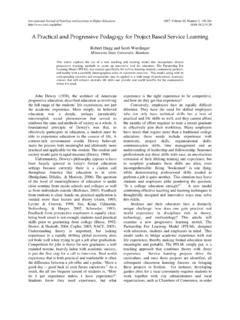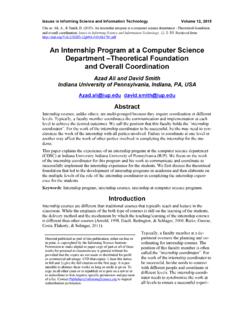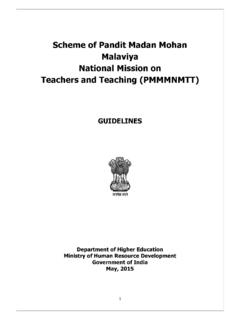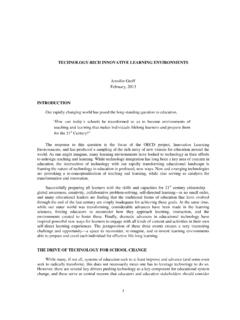Transcription of TH CHAPTER 4 DESIGN AND METHODOLOGY
1 Cogill J (2008). Primary teachers interactive whiteboard practice across one year: changes in pedagogy 1 and influencing factors. EdD thesis King s College University of London. Available at CHAPTER 4 DESIGN METHODOLOGY AND DATA ANALYSIS This CHAPTER describes the underlying paradigms, methods of the research DESIGN , the interpretive practice and the process of data analysis adopted for this thesis. In the final sections I discuss the major themes emerging from the data and the validity of my research. My Institution Focused Study (IFS) (Cogill, 2002) was the pilot study for this thesis. From this pilot I perceived that teachers practice in their use of the interactive whiteboard varied considerably between teachers.
2 In CHAPTER one I have explained how using a semi-ethnographic approach, I decided upon the major research questions: 1. Do teachers change the way they teach during one year of interactive whiteboard use and if so how? 2. What are the factors that may influence whiteboard pedagogy ? I have also developed the research DESIGN of my thesis as a consequence of learning from the methodological experiences of my IFS and will refer to these in this CHAPTER . Underlying paradigms of the research DESIGN Although my pilot study (Cogill, 2002) adopted a qualitative approach using interviews and classroom observations, for this thesis I have re-examined the underlying paradigms and my reasons for using a similar approach.
3 Qualitative versus quantitative METHODOLOGY The aim of my research was to seek illumination and understanding in teachers use of the interactive whiteboard rather than, for example, determine data on the frequency of use of different whiteboard practices. Laws and McLeod (2004) suggest that while a quantitative research DESIGN identifies and isolates specific variables, a qualitative DESIGN focuses on a holistic view of what is being studied: Quantitative DESIGN tends to control for bias so that facts are understood in an objective way, the qualitative approach strives to understand the perspective .. looking to firsthand experience to provide meaningful data. (Laws and McLeod 2004, page 2) I agree with Hoepfl (1997) that a quantitative enquiry cannot address either firsthand experience or the complex and dynamic quality of teaching and the behaviours of teachers as they occur in the contextual social world.
4 Furthermore my pilot had provided only a snapshot of whiteboard activity with one interview and one observation per teacher and for this thesis I wished to address teachers behaviour over a period of time. Apart from the epistemological reasons for choosing an interpretive rather than a positivist approach, there were further, practical reasons why an approach via questionnaire was felt to be inappropriate. It seemed unlikely that data of this nature could be gained through the impersonal nature of a questionnaire, since it required asking teachers about their pedagogical values and beliefs which are situated in a social world. In addition in 2002 not only was it becoming increasingly difficulty to send questionnaires to schools owing to the data protection act but there was little prior research available on interactive whiteboards on which to base appropriate research questions.
5 Consequently for both epistemological and pragmatic reasons I adopted a qualitative METHODOLOGY using a case study approach to enable teachers behaviours to be explored in detail and over a period of time. Case study approach Hitchcock and Hughes (1995) regard case study research as appropriate to a school setting because its principle rationale is to reproduce social action in its natural setting (p323). They also consider that the facility of case studies to develop new theory or evaluate existing practice provides Cogill J (2008). Primary teachers interactive whiteboard practice across one year: changes in pedagogy 2 and influencing factors. EdD thesis King s College University of London. Available at a potentially significant contribution within the particular context of teaching.
6 Stake (1995) suggests that it is the need to appreciate the uniqueness and complexity of a situation, of the embedding and interaction with contexts that creates circumstances appropriate to case study research. Yinn (1994) echoes this view: You would use the case study method because you deliberately wanted to cover contextual conditions believing that they might be highly pertinent to your phenomenon of study. (p13) The issues that are important in studying cases are not straightforward but intrinsically linked to social, historical and personal environments. Hodkinson and Hodkinson (2001) propose both strengths and limitations of case study research as summarised in the table below. Strengths Limitations helps understanding of complex inter-relationships easy to dismiss by those who do not like the messages that they contain grounds data in lived reality cannot answer a large number of relevant and appropriate research questions and does not lend itself to numerical representation facilitates the exploration of the unexpected and unusual the complexity examined is difficult to represent simply enables research to focus on the significance of the idiosyncratic through the use multiple cases.
7 Not generalisable in the conventional sense helps show the processes involved in causal relationships strongest when researcher expertise and intuition are maximised, but this raises doubts about objectivity facilitates rich conceptual/theoretical development. there is too much data for easy analysis and work is expensive if attempted on a large scale Table : Strengths and limitations of case study research (Hodkinson and Hodkinson, 2001) Some of the limitations cited are pragmatic in that they address the time and cost of case study research. Those concerning generalisation I will discuss in the next section. I was however especially interested in the research conducted by Hodkinson and Hodkinson (2001) which gave rise to the table above.
8 The research tracked 12 trainees through interviews across a range of stakeholders over an 18 month period enabling the examination of complex interrelationships. The DESIGN adopted struck a chord since I consider it pertinent to my own research DESIGN . My initial interest was to create a research structure to investigate any pedagogical change in teachers as a result of whiteboard intervention. Therefore, it was necessary to consider the social setting and the context in which teachers were working. Teacher learning .. involves the complex interrelationship between individual careers and dispositions to learning, the cultures of school and department, and the broader social, economic, political and above all, policy contexts in which teachers are currently working and have worked in the past.
9 (Hodkinson and Hodkinson 2001, p8) Later as my research progressed I decided to address the different experiences of two schools, so required the opportunity as Mason (2002) suggests, to consider data in different ways. A case study approach met both of these needs. As Stenhouse (1982), Hitchcock and Hughes (1995), Yinn (1994) and Hoepfl, 1997) point out, case studies facilitate rich, conceptual, theoretical development within the context of teacher learning. Cogill J (2008). Primary teachers interactive whiteboard practice across one year: changes in pedagogy 3 and influencing factors. EdD thesis King s College University of London. Available at Generalisation in case study research Hodkinson and Hodkinson (2001) consider how case studies can provide more than just idiosyncratic understanding.
10 They prefer not to use the term generalisation but consider that cases may shed light on issues beyond the immediate context in which the research was undertaken. The researchers make three claims on how findings can illuminate other situations Theory can be transposed beyond the original study. If case studies generate new thinking then new concepts may be relevant to other settings. Findings can ring true in other settings. It is up to the reader to decide if the analysis presented is convincing, based on their own knowledge of other similar situations and of contexts to which such knowledge may be transferred. Case studies can provide provisional truths . If there has been little previous theorising in a field of study then evidence from a case study may provide initial provisional theory.
